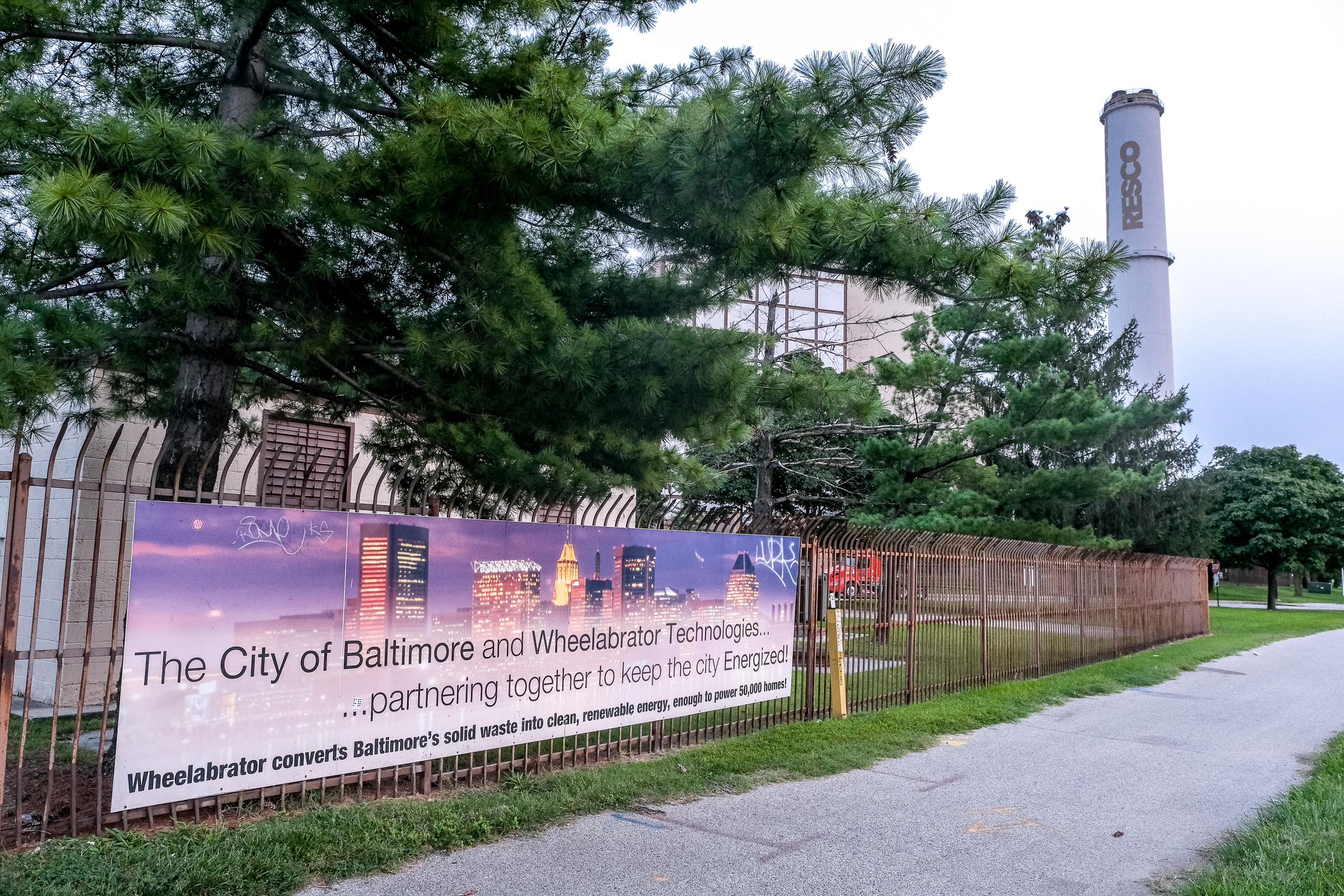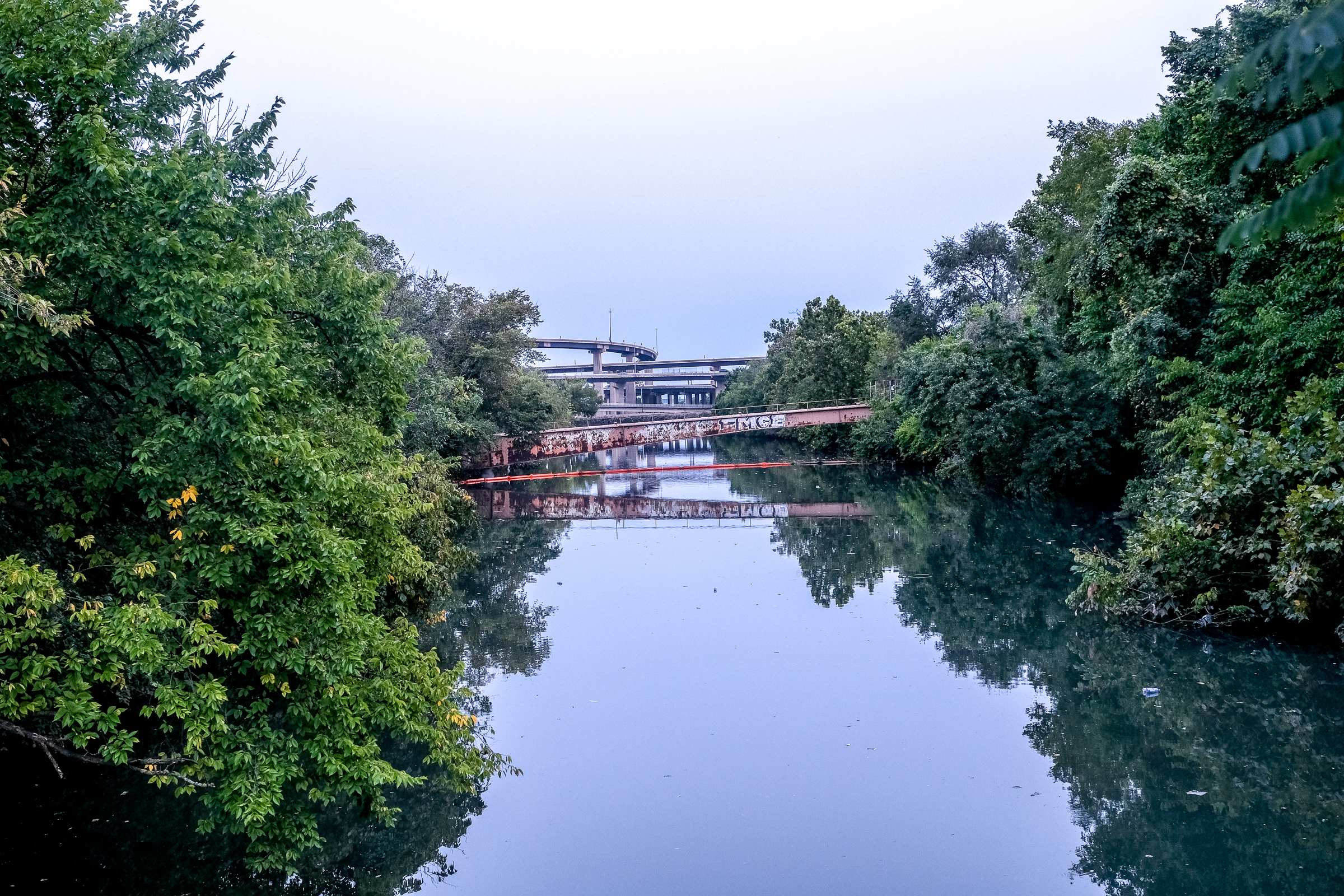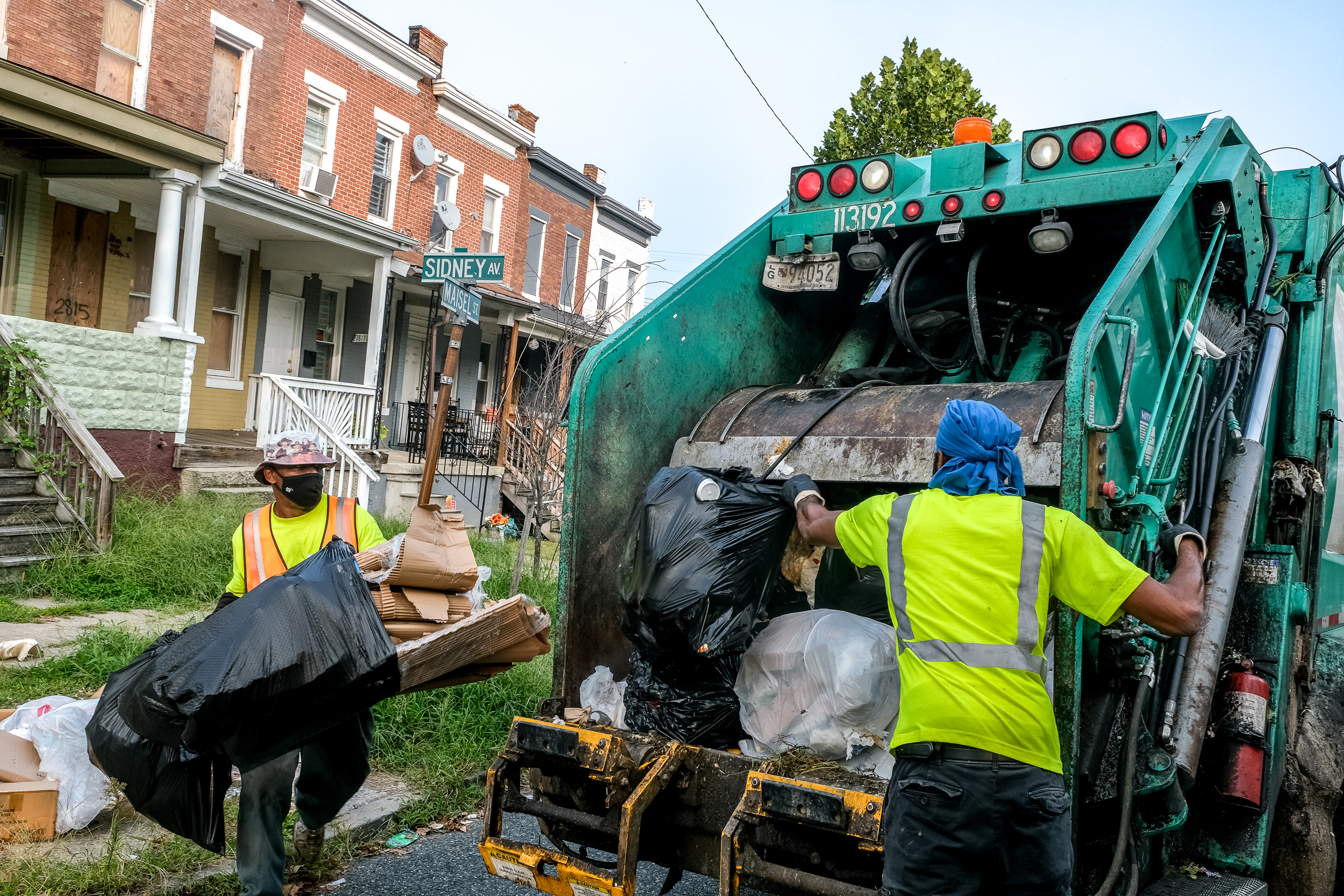It’s time to wake up. On Global Day of Climate Action, VICE Media Group is solely telling stories about our current climate crisis. Click here to meet young climate leaders from around the globe and learn how you can take action.
During a record-breaking heatwave this summer, dozens of Baltimoreans linked arms outside the gates of an industrial facility that, for commuters driving on Interstate 95, appears unremarkable in a city dotted with factories. For the mostly Black residents of the surrounding South Baltimore neighborhoods, the Baltimore Refuse Energy Systems Co., or BRESCO, has been the object of their ire for close to a decade.
As the primary way that Baltimore disposes of waste, BRESCO incinerates 2,250 tons of trash every day down to ash a quarter of the weight. The facility, which has been operating since 1985, generates 5% of the city’s electricity. But it’s also the single largest source of pollution in Baltimore, which is ranked one of the most polluted cities in the country. Residents there are plagued by asthma and mortality rates of cancer, heart disease, and stroke far outpace the national average.
“Damn near everyone here has a breathing issue. The air is different. It’s a silent killer,” Keisha Allen, a South Baltimore neighborhood association president, told VICE News. “It’s been a recipe for all sorts of health problems. We can no longer serve as the armpit of the city.”
After months of a pandemic that has disproportionately infected people of color—especially those in heavily polluted neighborhoods, Baltimore residents have ratcheted up pressure on City Hall to shut down the incinerator. They want to implement a new “zero-waste” plan to reduce trash, create green jobs, and improve air quality—and they finally have a candidate on their side. But Wheelabrator, BRESCO’s operator, is fighting back. And with a history of financial issues, illegal dumping, and spotty recycling efforts, the city will have a hard time making zero-waste a success.

On the day of the demonstration in July, residents and activists were out in force to stop the hundreds of trash trucks that unload at BRESCO every day. After months of demonstrations against police brutality outside City Hall, tensions were already high. Activists had just discovered that the city and Mayor Bernard C. “Jack” Young were in negotiations with Wheelabrator that could subvert years of legal battles, door-to-door canvassing, and unanimous city council votes. They wanted to make sure Young, who became mayor last year when the previous mayor resigned due to a criminal scandal, knew they were paying attention.
Shashawnda Campbell, a 23-year-old South Baltimore native, was furious.
“Mayor Young was not elected by the people and he thinks he can destroy efforts that took years to build?” she told VICE News. “It's really sad that this is what we have to do to get people to hear that our lives matter.”
When Campbell was 15, she and her classmates at Benjamin Franklin High School in South Baltimore helped stop another incinerator from being built that would have been the biggest in the nation.
But incinerators are far from the only problem for the neighborhood — and for a city with a decades-long reliance on industry, closing down BRESCO will require nothing less than a dramatic upheaval of how Baltimore runs.
‘It smells like death’
BRESCO currently burns around half of the city’s residential waste, or about 174,000 tons annually. The rest of the 700,000 tons burned there every year comes from the city’s commercial waste, which is handled privately or hauled from surrounding counties that have contracts with Wheelabrator.
Burning that trash releases hundreds of thousands of pounds of carbon dioxide every year, as well as toxic chemicals like mercury, lead, and hydrochloric acid, according to the Environmental Protection Agency (EPA). It also makes BRESCO the city’s single biggest source of nitrogen oxide and a major source of sulfur oxide, both indirect greenhouse gases responsible for smog and acid rain and worsening the climate crisis.
South Baltimore also houses the Quarantine Road Landfill—where all of BRESCO’s toxic ash is dumped—the country’s largest medical waste incinerator, a wastewater treatment facility, a major coal exporting port, and an animal rendering plant. Over a dozen sites nearby have been designated Brownfields, or land contaminated by industrial use, by the EPA.
“If you drive here at certain times of night, it smells like death. Everything that is stinky, polluting, gross, and will kill you is down here,” Allen said.
In Westport, where BRESCO is located, residents are 1.4 times as likely to die of lung cancer than the city average. Asthma hospitalization rates are more than twice the state average in Curtis Bay, which houses the medical waste incinerator and other industrial facilities, and close to that in Westport.
“Damn near everyone here has a breathing issue. The air is different. It’s a silent killer.”
Multiple studies, one of which was commissioned by Wheelabrator, have found no clear links between asthma rates and air quality or emissions in Baltimore. But there’s no doubt residents are suffering. The average life expectancies in multiple South Baltimore neighborhoods are less than 70, according to the city health department. Drive 10 miles north to wealthy Roland Park and it jumps to 84.
“When you put these large single sources of emissions in communities that are health-compromised and are already being bombarded with lots of other pollution sources, it has a cumulative effect,” said Ana Baptista, the associate director of The New School’s Tishman Environment and Design Center and the author of an extensive review of the incineration industry.
But emissions from cars, trucks, and other vehicles in Baltimore dwarf that of BRESCO. A study conducted by an environmental watchdog group concluded that vehicles are by far the largest contributor to respiratory issues in Baltimore, according to EPA data.

With South Baltimore encircled by highways and Interstate 95, eliminating BRESCO could have a negligible impact on the area’s air quality and health outcomes.
“The key is that the emissions are not air quality. People are not living at the edge of the stack,” said Rosanne McIntyre, an epidemiologist and scientific consultant who was hired by Wheelabrator to conduct a review of studies associated with BRESCO.
BRESCO isn’t going down without a fight
The city’s most recent long-term contract with Wheelabrator runs out at the end of 2021, and City Council President Brandon Scott, who won the Democratic mayoral primary and is therefore a near lock for the November election, opposes any new contract. Scott and the city council have called for the adoption of “zero-waste” policies like those in San Francisco. They mandate composting and recycling programs that dramatically reduce waste and divert materials from incinerators and landfills.
As with everything in the modern American city, challenging the established system is not that simple.
With no direct way to close the incinerator, the city council unanimously passed a Clean Air Act last year which required incinerators to monitor 20 major pollutants in real-time and severely limit emissions of nitrogen oxide.
The law, written by Mike Ewall, the executive director of the Energy Justice Network and an anti-incineration activist for 30 years, was designed to force Wheelabrator to install upgrades estimating $95 million, according to a city-commissioned report. The hope among activists and city council members was that the upgrades would be too costly for the facility to stay open.
The emissions limit set by the legislation would only be achievable with selective catalytic reduction technology that is cost-prohibitive and potentially impossible to implement at BRESCO due to space limitations, according to Marco Castaldi, a professor of chemical engineering at City University of New York, City College and a leading expert on waste-to-energy technologies.
Wheelabrator sued the city, arguing that existing federal and state environmental laws don’t allow municipalities to enact stricter emissions regulations. Mike Dougherty, Wheelabrator’s Baltimore market manager, declined to comment on the lawsuit but told VICE News that BRESCO already has “highly effective and efficient air quality controls” that have kept it well within regulations.
A federal judge ruled in Wheelabrator’s favor in April, and Baltimore appealed, but it’s anyone’s guess what happens next. The city filed a motion over the summer asking to delay hearings so the parties could conduct settlement negotiations.
“That facility is going to be shut down by the end of 2021 even if we have to lay down in front of the trucks.”
If the city and Wheelabrator settle the lawsuit, it would likely mean that the company agreed to upgrade the pollution controls, as set by the Clean Air Act, in exchange for a new long-term contract, according to Ewall.
Just about everyone working on the issue expressed worry that Young might push through a settlement and a new contract before he leaves office in December. A new contract of 5, 10, or even 20 years would tie the hands of Scott, the presumptive new mayor, before he enters office.
“The situation we find ourselves in now is that Wheelabrator recognizes that it needs, in order to continue to profiting off burning trash in Baltimore, to undercut the democratic decisions that Baltimore residents have made and city leadership has committed to,” Greg Sawtell, an organizer with United Workers and a member of the City’s Sustainability Commission, told VICE News.
No city has hit ‘zero-waste'
Baltimore would be far from the first city to pursue zero-waste. Cities like Austin, Los Angeles, New York, and Oakland are implementing plans that would improve recycling and composting in the hope of making incineration and landfilling obsolete.
None are there yet.
San Francisco is the poster child for zero-waste, having instituted an aggressive plan in 2002 to reach 100% diversion by 2020. Recycling and composting is mandatory for all businesses and residences, and the city provides residents with recycling and composting bins; economic incentives; and continuous education. Waste is managed at state-of-the-art facilities that better sort recyclables, prevent contamination, and process compost. This labor-intensive system is funded entirely by garbage collection fees, which average $35 a month per household.
The plan has been successful—to a point. In 2012, the city diverted 60% of its trash from landfills, far better than the national average of 35%. By 2018, however, the rate had slipped to 51%.

While reducing, reusing, and recycling are key to handling waste, zero-waste efforts could backfire.
Up until recently, much of the U.S.’ recycling was sent to China to be processed. But, in 2018, the country stopped accepting most foreign materials, tanking the recycling market and forcing many municipalities to burn their recyclables or put them in landfills. In addition, less than 10% of plastic is recycled in the U.S., largely because it’s not economically feasible.
Unless there’s a sea change in how goods are manufactured and packaged, there will always be plastic trash to dispose of. Closing waste-to-energy incinerators and similar facilities would leave only one option: landfilling, which takes up space and emits methane, a greenhouse gas far more dangerous than carbon dioxide.
“This hope to recycle everything is beyond what’s possible,” Nickolas Themelis, the founder of Columbia University’s Earth Engineering Center and a major proponent of waste-to-energy incinerators, told VICE News. “It’s never been done in the world.”
Other cities’ challenges with waste have not discouraged Baltimore. In February, a community coalition released a zero-waste plan with the support of the Baltimore city council to recycle, reuse or compost 90% of the city’s trash. In August, the Department of Public Works released a competing “Less Waste” plan, designed by environmental engineering consultants, that aims to hit 83%.
The plans call for initiatives similar to those of other cities to improve Baltimore's abysmal residential recycling rate of 15%: extensive education and outreach, laws banning certain materials and mandating recycling, and the establishment of a composting program, repair clinics, and reuse libraries for items like shop tools or kitchen appliances. Both plans tout the jobs and small businesses that could be generated by the new waste system.
“If you build up a zero-waste economy, you could get those jobs that we’re desperately trying to get from huge corporations, but you could localize them,” said Dante Swinton, an environmental justice researcher at Energy Justice Network who ran for mayor in the Democratic primary on a zero-waste and fair-development platform.
Where the two plans differ is how fast and how much the city can divert and, therefore, what to do about BRESCO. The Department of Public Works’ report ultimately recommends a new contract with Wheelabrator to provide time to build up new programs and construct a transfer station to haul leftover waste to landfills out of state.
But activists and city council members don’t want to wait to close BRESCO, and many believe the city-owned Quarantine Road landfill, which is due for an expansion, could sufficiently handle waste while zero-waste programs are ramped up. The Department of Public Works’ projections suggest the expanded landfill would, best-case scenario, last only until 2032 if BRESCO closes.
For zero-waste advocates, it’s a risk the city has to take. If the city signs another contract with Wheelabrator, according to Mary Pat Clarke, a city council member, it’s unlikely the company will make the $95 million upgrades, mandated by city law, without passing that cost on taxpayers.
“The more we recycle and reuse, the more we pay for more diminishment of our trash and that can go on for years,” said Clarke, who introduced a bill this week to ban any new city contracts with incinerators. “We’ve seen it in other subdivisions and we know how expensive and wasteful it is.”
Whatever the city decides, the challenge is immense. At a recent city planning meeting to present the Department of Public Works’ plan, Matthew Garbark, its director, noted that the city has seen a 25-50% increase in waste since March, and recycling programs were recently suspended until November due to the pandemic.
Wheelabrator has committed to placing and staffing recycling dumpsters in various neighborhoods until the suspension is over. And the company had already distributed over 1,400 recycling bins to residents.
It’s also planning to continue operating, with a city contract, past 2021.
“There’s no way we would swallow that without raising bloody hell,” Ewall said. “That facility is going to be shut down by the end of 2021 even if we have to lay down in front of the trucks.”
from VICE US https://ift.tt/3kRLGYl
via cheap web hosting

“Plain and simple, Benjamin Lee is the nicest person and the best loan officer at his service. We had a very bumpy road during our entire Business renovation process, due to circumstances out of funds. Mr Ben stayed on top of all parties to make sure everything stayed on track in order to meet our tight deadline to close our loan. We appreciate everything he did for us and we highly recommend him and his loan company to anyone looking to obtain financing. Thanks again Mr Ben.
ReplyDeleteContact Mr BEN On: 247officedept@gmail.com Also on Whatsapp : +1-989-394-3740.